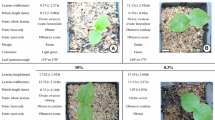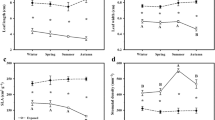Summary
Plasticity of plant traits is commonly quantified by comparing different phenotypes at the same age. In this paper, we present a method in which the effect of resource conditions on plant weight is used as a basis for quantifying the plasticity of individual plant traits. Abutilon theophrasti individuals were grown in, and some transferred between, high and low intensity light conditions, resulting in four phenotypes. Plant traits were found to exhibit different degrees of plasticity, decreasing in this order: height; specific leaf area; allocation to branch roots; allocation to leaf area; number of nodes; allocation to tap roots; allocation to stem; allocation to leaf weight. Under these conditions, individuals of the four phenotypes had very similar heights when compared at the same age, but very different heights when compared at the same plant weight. The latter comparison indicates that light intensity influences height independently of its influence on plant weight. Individuals that were transferred from high to low light had greater allocation that had not been transferred, but individuals of all phenotypes had nearly the same leaf weight allocation when compared at the same plant weight. The latter comparison indicates that light intensity influeces leaf weight allocation mostly by influencing plant weight. In the phenotype resulting from the transfer of plants from low to high light, reproduction was stimulated much less than plant weight and axillary leaf growth, and reproductive allocation was delayed relative to the other three phenotypes. We conclude that when plasticity is measured by comparing phenotypes at the same plant weight, the effects of resources on plant size can be excluded from the quantification.
Similar content being viewed by others
References
Bazzaz FA, Carlson RW (1982) Photosynthetic acclimation to variability in the light environment of early and late successional plants. Oecologia 54:313–316
Benner BL, Bazzaz FA (1985) Response of the annual Abutilon theophrasti Medic. (Malvaceae) to timing of nutrient availability. Am J Bot 72:320–323
Bjorkman O (1981) Responses to different quantum flux densities. In: Lange OL, Nobel PS, Osmond CB, Ziegler H (eds) Physiological Plant Ecology I. (Encyclopedia of Plant Physiology, NS, vol 12B) Springer, Berlin Heidelberg New York, pp 57–107
Blackman GE, Black JN (1959) Physiological and ecological studies in the analysis of plant environment. Ann Bot N Ser 23:51–63
Blackman GE, Wilson GL (1954) Physiological and ecological studies in the analysis of plant environment. IX. Adaptive changes in the vegetative growth and development of Helianthus annuus induced by alteration in light level. Ann Bot 18:71–94
Chapin FS III (1980) The mineral nutrition of wild plants. Ann Rev Ecol Syst 11:233–260
Charles-Edwards DA, Charles-Edwards J, Sant FI (1974) Leaf photosynthetic activity in six temperate grass varieties grown in contrasting light and temperature environments. J Exp Bot 25:715–724
Cooper CS (1967) Relative growth of alfalfa and birdsfoot trefoil seedlings under low light intensity. Crop Sci 7:176–179
Evans GC, Hughes AP (1961) Plant growth and the aerial environment. I. Effects of artificial shading on Impatiens parviflora. New Phytol 98:433–446
Flint SD, Palmblad IG (1978) Germination dimorphism and developmental flexibility in the ruderal weed Heterotheca grandiflora. Oecologia 36:33–43
Garbutt K, Bazzaz FA (1984) The effects of elevated CO2 on plants III Flower, fruit and seed production and abortion. New Phytol 98:433–446
Harter HL (1961) Expected values of normal order statistics. Biometrika 48:151–165
Hughes AP, Cockshull KE (1971) The effects of light intensity and carbon dioxide concentration on the growth of Chrysanthemum morifolium cv. Bright Golden Anne. Ann Bot N Ser 35:899–914
Hughes AP, Evans GC (1962) Plant growth and the aerial environment. II. Effects of light intensity on Impatiens parviflora. New Phytol 61:154–174
Hunt R, Bazzaz FA (1980) The biology of Ambrosia trifida L. V. Response to fertilizer, with growth analysis at the organismal and sub-organismal levels. New Phytol 84:113–121
Hurd RG, Thornley JHM (1974) An analysis of the growth of young tomato plants in water culture at different light integrals and CO2 concentrations. I. Physiological aspects. Ann Bot 38:375–388
Jurik TW, Chabot BF (1982) Effects of light and nutrients on leaf size, CO2 exchange, and anatomy in wild strawberry (Fragaria virginiana). Plant Physiol 70:1044–1048
Lacey EP (1986) The genetic and environmental control of reproductive timing in a short-lived monocarpic species Daucus carota (Umbelliferae). J Ecol 74:73–86
Langenheim JH, Osmond CB, Brooks A, Ferrar PJ (1984) Photosynthetic responses to light in seedlings of selected Amazonian and Australian rainforest tree species. Oecologia 63:215–224
Mahall BE, Parker VT, Fonteyn PJ (1981) Growth and photosynthetic irradiance responses of Avena fatua L. and Bromus diandrus Roth and their ecological significance in Californian savannas. Photosynth 15:5–15
McIntyre GI (1977) The role of nutrition in apical dominance. Symp Soc Exp Biol 31:251–274
McLaren JS, Smith H (1978) Phytochrome control of the growth and development of Rumex obtusifolius under simulated canopy light enviroments. Plant Cell Environ 1:61–67
Morgan DC, Smith H (1981) Control of development in Chenopodium album L. by shadelight: the effect of light quantity (total fluence rate) and light quality (red: far-red ratio). New Phytol 88:239–248
Patterson DT, Duke SC, Hoagland RE (1978) Effects of irradiance during growth on adaptive photosynthetic characteristics of velvetleaf and cotton. Plant Physiol 61:402–405
Peterson DL, Bazzaz FA (1978) Life cycle characteristics of Aster pilosus in early successional habitats. Ecology 59:1005–1013
Phillips JDJ (1975) Apical dominance. Annual Review of Plant Physiol 26:341–367
Reekie EG, Bazzaz FA (1987) Reproductive effort in plants. I. Carbon allocation to reproduction. Am Nat 129:876–896
Rice SA (1987a) Environmental variability and phenotypic flexibility in plants. PhD thesis, University of Illinois
Rice SA (1987b) Plasticity and acclimation of stem vascularization in Abutilon theophrasti. Bull Ecol Soc Am 68:396
Rice SA, Bazzaz FA (1989) Growth consequences of plasticity of plant traits in response to light conditions. Oecologia 78: 508–512
St. Omer L, Horvath SM (1983) Elevated carbon dioxide and whole plant senescence. Ecology 64:1311–1314
University of Nebraska Computer Network 1976. ITS STAT User's Manual. United Computing Systems Inc
Yun JI, Taylor SE (1986) Adaptive implications of leaf thickness for sun- and shade-grown Abutilon theophrasti. Ecology 67:1314–1318
Author information
Authors and Affiliations
Rights and permissions
About this article
Cite this article
Rice, S.A., Bazzaz, F.A. Quantification of plasticity of plant traits in response to light intensity: comparing phenotypes at a common weight. Oecologia 78, 502–507 (1989). https://doi.org/10.1007/BF00378741
Received:
Issue Date:
DOI: https://doi.org/10.1007/BF00378741




